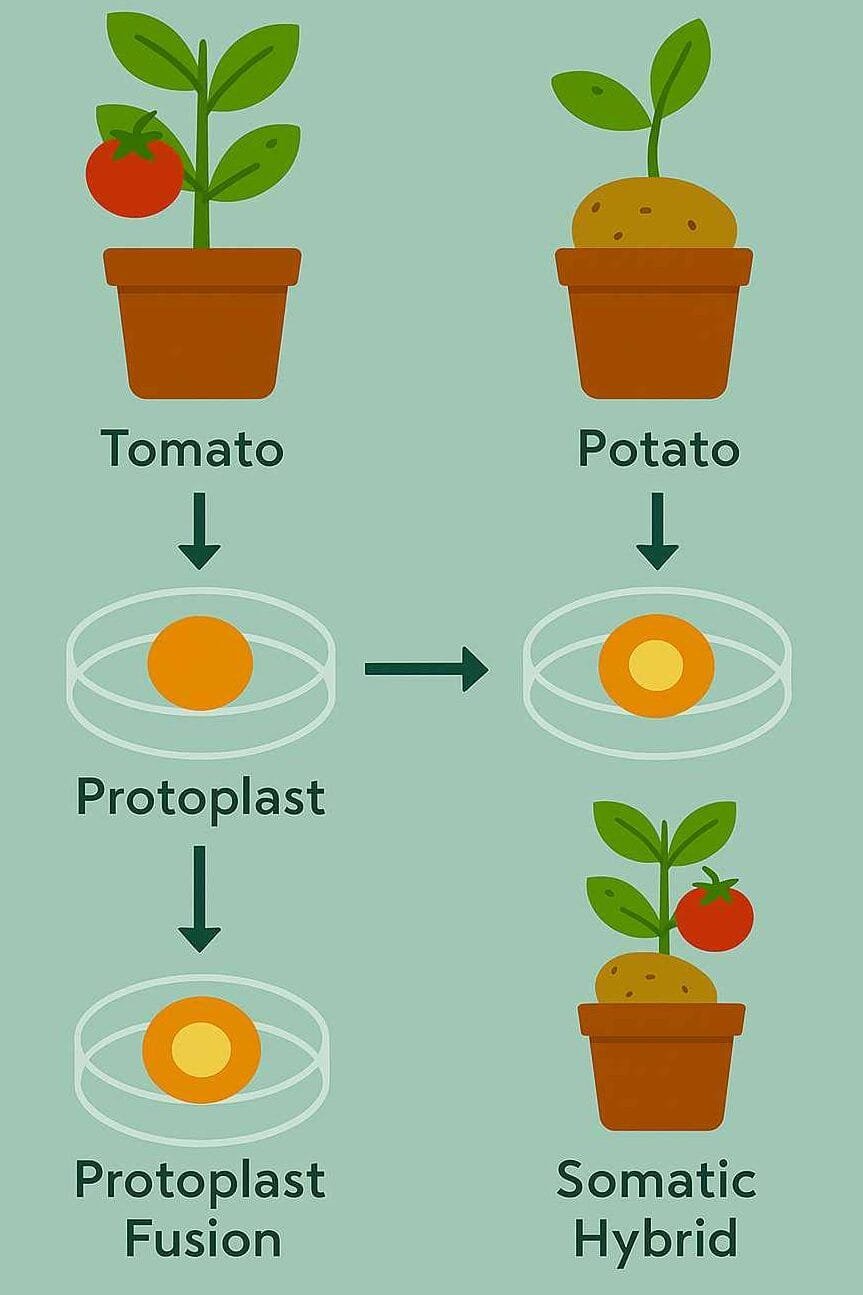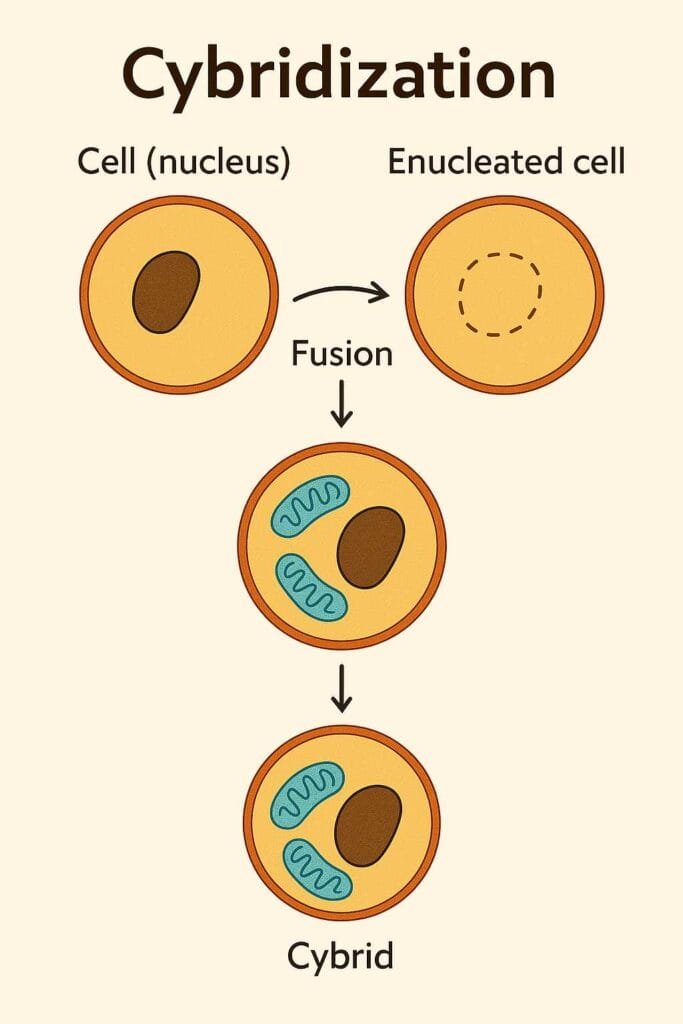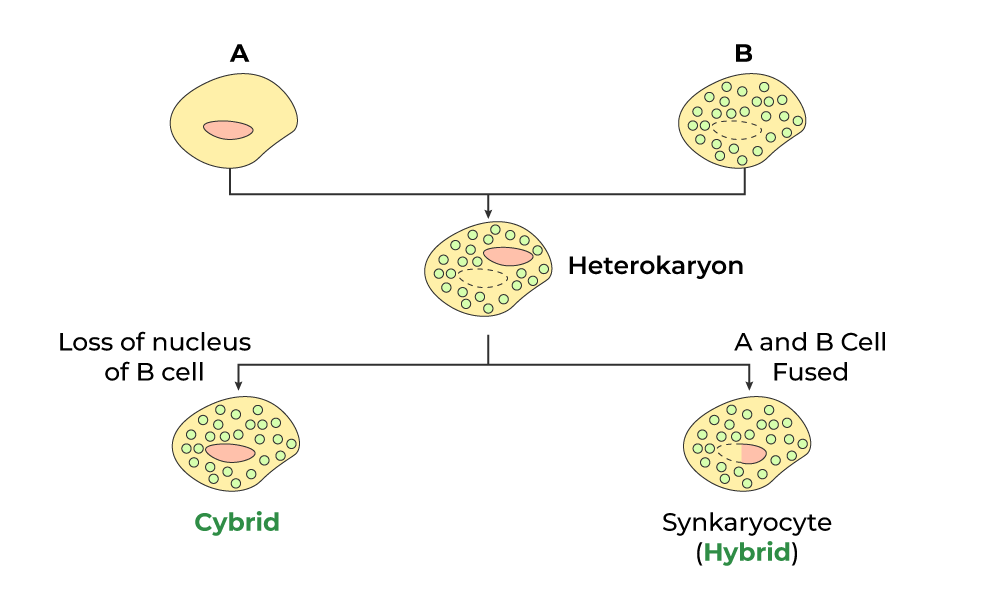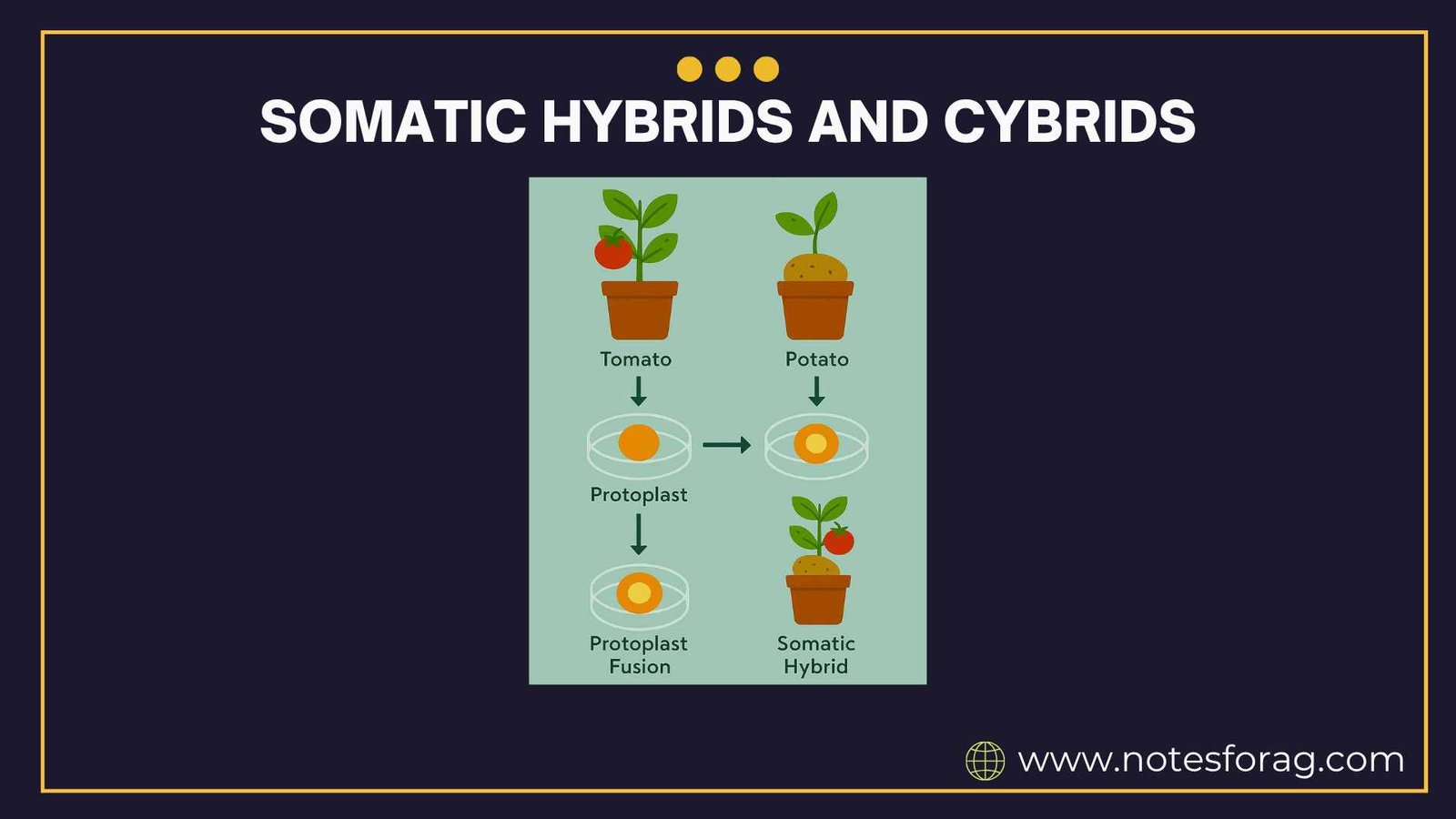Introduction to Somatic Hybrids and Cybrids
In the field of plant biotechnology, somatic hybrids and cybrids represent important breakthroughs in the development of novel crop varieties. These techniques are built on the manipulation of protoplasts plant cells without cell walls which can be fused to create hybrid cells that combine traits from different species or even genera. Somatic hybridization involves the fusion of two entire protoplasts, leading to the combination of both nuclear and cytoplasmic genomes.

On the other hand, cybridization, or cytoplasmic hybridization, results in the fusion of a complete protoplast with another whose nucleus has been inactivated or removed, allowing only cytoplasmic material, including organelles like mitochondria and chloroplasts, to be transferred. These advanced tools offer unique solutions to several limitations in traditional breeding, such as sexual incompatibility and restricted gene pools. They open new avenues for enhancing traits like disease resistance, abiotic stress tolerance, and yield potential.
Summary of Somatic Hybrids
- Somatic hybrids and cybrids are advanced biotechnological tools used to combine desirable traits from different plant species, overcoming limitations of traditional breeding.
- Somatic hybridization enables the merging of entire nuclear genomes, while cybridization focuses on transferring cytoplasmic traits like cytoplasmic male sterility (CMS) and organelle function.
- These techniques have practical applications in improving disease resistance, stress tolerance, and yield in crops like potato, Brassica, citrus, and rice, with promising potential for future agricultural innovations.
Table of Contents
Understanding the Techniques
Somatic Hybridization
Somatic hybridization starts with the isolation of protoplasts from two different parent plants, often from distantly related species. These protoplasts are then fused using methods like polyethylene glycol (PEG) treatment or electrofusion. Once fusion occurs, the hybrid cell is cultured under specific conditions that encourage cell wall regeneration, cell division, and eventually, the formation of a callus. This callus can be induced to regenerate into a whole plant, known as a somatic hybrid. The key advantage of this technique is that it allows the combination of entire nuclear genomes, enabling the transfer of complex traits that might be difficult to introduce through conventional breeding.
Cybridization

Cybridization involves a similar protoplast fusion process but with a crucial difference: only one of the parent cells contributes a functional nucleus, while the other contributes only cytoplasmic organelles. This is achieved by treating one of the parent protoplasts with radiation or chemicals that destroy or deactivate the nucleus. The resulting cytoplasmic hybrid, or cybrid, carries the nuclear genome of one parent and the mitochondrial and/or chloroplast genomes of the other. Cybrids are particularly useful for studying cytoplasmic inheritance and for transferring desirable cytoplasmic traits such as cytoplasmic male sterility (CMS), which is widely used in hybrid seed production.
Applications of Somatic Hybrids in Crop Improvement

Overcoming Sexual Incompatibility
One of the most significant applications of somatic hybridization is the ability to cross species or genera that are sexually incompatible. Traditional breeding relies on the sexual compatibility of parent plants, which limits the gene pool. Somatic hybridization bypasses this limitation by allowing the combination of genomes from unrelated species. This has enabled the creation of hybrids that could never be produced through pollination, expanding the genetic diversity available for crop improvement.
Introduction of Disease Resistance
Somatic hybrids have been successfully used to introduce disease resistance from wild or resistant relatives into cultivated species. For example, in the potato (Solanum tuberosum), somatic hybridization with wild species has allowed the transfer of resistance to pathogens like Phytophthora infestans, the causative agent of late blight. Similarly, in Brassica crops like cabbage and mustard, resistance to clubroot disease has been introduced through somatic hybridization with resistant wild relatives. These hybrids retain the desirable traits of the cultivated species while gaining resistance traits from the wild species.
Enhanced Abiotic Stress Tolerance
Abiotic stresses such as drought, salinity, and extreme temperatures pose significant challenges to crop productivity. Somatic hybridization has been employed to develop hybrids that can withstand these harsh environmental conditions. By combining the genetic material of stress-tolerant wild species with high-yielding cultivars, researchers have created somatic hybrids that exhibit improved tolerance to water scarcity, soil salinity, and temperature fluctuations. This contributes to the development of climate-resilient crops that can maintain productivity under changing environmental conditions.
Improvement in Yield and Quality
While disease resistance and stress tolerance are primary goals, somatic hybrids also contribute to improvements in yield and crop quality. By merging genomes from different species, it is possible to combine traits such as increased biomass, larger fruit size, better nutritional content, and longer shelf life. For instance, in citrus breeding, somatic hybridization has been used to combine sweet and disease-resistant varieties, resulting in hybrids with both good taste and resilience.
Development of Novel Crop Varieties
Somatic hybridization enables the creation of entirely new plant types with unique combinations of traits not found in nature. These novel hybrids can exhibit hybrid vigor or heterosis, which often leads to enhanced growth, yield, and adaptability. In some cases, somatic hybrids have been used to create new rootstocks for grafting in fruit trees, offering improved resistance to soil-borne diseases and pests.
Applications of Cybrids in Crop Improvement
Transfer of Cytoplasmic Male Sterility (CMS)
One of the most valuable applications of cybrids is the transfer of cytoplasmic male sterility, a trait that prevents pollen production and thus allows for the production of hybrid seeds without manual emasculation. CMS systems are widely used in crops like rice, maize, sunflower, and Brassicas. By transferring CMS traits from wild relatives or unrelated species into fertile cultivars, cybrids facilitate efficient hybrid seed production, reducing labor and increasing genetic gain.
Enhancing Organellar Traits
Cybrids allow for the manipulation of organellar genomes, particularly mitochondrial and chloroplast DNA. This can be beneficial for improving photosynthetic efficiency, metabolic processes, and overall plant vigor. For example, changes in mitochondrial genes can affect respiration and energy production, which are critical for plant growth and yield. Similarly, modified chloroplast traits can enhance photosynthesis and biomass accumulation.
Studying Cytoplasmic Inheritance
Cybrids provide a unique platform for studying the inheritance and function of cytoplasmic genes. Since the nuclear genome is constant, any observed variations in phenotype can be attributed to the organellar DNA. This helps researchers understand how mitochondrial and chloroplast genomes influence plant development, fertility, and resistance to various stresses. Insights from such studies can lead to targeted improvements in crop performance.
Creation of Novel Germplasm
Like somatic hybrids, cybrids can be used to generate novel plant material with unique genetic combinations. These new lines can serve as valuable resources for further breeding programs. The ability to manipulate cytoplasmic traits allows breeders to fine-tune crop characteristics and create germplasm that combines favorable traits from different species or genotypes.
Case Studies and Real-World Applications
Potato Improvement
In potato breeding, somatic hybridization has played a crucial role in transferring resistance to viruses, bacteria, and fungi from wild Solanum species into cultivated potatoes. These hybrids not only show improved disease resistance but also retain high tuber quality and yield. Cybrids have been used to modify cytoplasmic traits linked to tuber quality and storage.
Brassica Breeding
In Brassica species like cabbage, mustard, and rapeseed, both somatic hybrids and cybrids have been used extensively. Somatic hybridization has helped introduce resistance to black rot, clubroot, and downy mildew. Cybrids have facilitated the stable incorporation of CMS traits, which are now routinely used in commercial hybrid seed production.
Citrus and Fruit Crops
Somatic hybridization in citrus has enabled the development of new rootstocks with combined resistance to diseases and pests. Cybrids have been explored for transferring chloroplast traits that influence fruit color, flavor, and photosynthetic efficiency. These efforts have improved the productivity and marketability of citrus fruits.
Rice and Cereal Crops
Although more challenging, research into somatic hybrids and cybrids in cereal crops like rice is ongoing. CMS systems derived from cybridization have already been implemented in rice breeding programs, contributing significantly to hybrid rice production. These hybrids show better yields and uniformity compared to conventional lines.
Challenges and Limitations
Despite their potential, the use of somatic hybrids and cybrids comes with certain challenges. One major issue is the regeneration of fertile plants from fused protoplasts, which is often species-dependent and technically demanding. There can also be problems with chromosome instability, unpredictable gene expression, and reduced fertility in hybrids. Furthermore, the process of protoplast isolation, fusion, and culture requires specialized facilities and expertise, limiting its widespread adoption. Regulatory concerns and public acceptance, particularly when genetic manipulation is involved, also play a role in the limited use of these techniques in commercial agriculture.
Future Prospects and Research Directions
Looking ahead, advancements in genomics, molecular biology, and tissue culture techniques are likely to enhance the efficiency and applicability of somatic hybridization and cybridization. Genome editing tools like CRISPR-Cas9 may be integrated with protoplast fusion techniques to allow for precise modifications of both nuclear and organellar genomes. High-throughput screening methods and improved culture protocols will make it easier to identify and propagate desirable hybrids. Additionally, the integration of bioinformatics will support better prediction of hybrid compatibility and trait expression. As global agriculture faces increasing pressure from climate change, population growth, and resource limitations, somatic hybrids and cybrids are poised to play an essential role in creating resilient, high-performing crops.
Conclusion
In conclusion, somatic hybrids and cybrids represent powerful tools in the modern plant breeder’s toolkit. Somatic hybrids enable the combination of nuclear genomes from different species, breaking traditional barriers and enhancing traits like disease resistance, stress tolerance, and yield. Cybrids offer a complementary approach, focusing on the transfer of cytoplasmic traits such as CMS and enhanced organelle function. Together, these techniques expand the genetic base of crop species and provide novel opportunities for crop improvement. While challenges remain, continued research and innovation will likely unlock their full potential, contributing significantly to sustainable agriculture and global food security in the years to come.
Frequently Asked Questions (FAQs)
Why use somatic hybridization instead of traditional breeding?
Somatic hybridization bypasses sexual incompatibility, enabling gene transfers including disease resistance or stress tolerance from distantly related species that can’t cross sexually.
What are the main limitations of somatic hybridization?
Although powerful, somatic hybrids often face challenges such as genetic instability, sterility, and difficulties in regenerating fertile plants limits intensified when parents are distantly related
What is the difference between somatic hybrids and cybrids?
Somatic hybrids are created by fusing two whole protoplasts, combining both nuclei and cytoplasm from each parent, while cybrids are made by fusing a whole protoplast with an enucleated one resulting in only one parent’s nucleus and mixed cytoplasm.
Related Articles

